On the occasion of centenary of the birth of Salvatore Fancello , the MAN is pleased to present, for the first time gathered in a single viewing path, the complete corpus of drawings by the artist from Dorgali preserved within the museum collection. A nucleus of over fifty works , representative of the different strands of Fancello’s graphic research, to which, within the framework of the exhibition, a further group of drawings will be added, recently obtained on loan and never exhibited before.
Born in 1999 by will of the Province of Nuoro, L he MAN collection it is the result of a careful selection of works by Sardinian artists from the end of the nineteenth century to the present day. A collection of around 600 works within which the large group of drawings by Fancello constitutes one of the most important and representative parts.
Salvatore Fancello’s artistic career takes place over just a decade, from the moment in which, in 1930, he moved to Monza to attend the Istituto Superiore per le Industrie Artistiche – also attended by his friends Giovanni Pintori and Costantino Nivola – until his subsequent stays in Milan, Padua and Albissola, concluding with the early death in war in 1941, on the Greek-Albanian front, at the age of only twenty-five.
Student of Giuseppe Pagano, Pio Semeghini, Raffaele De Grada, but also of Arturo Martini and Marino Marini , teachers of decorative plastic, Fancello refined his skills in Monza ceramist skills , a discipline he had learned as a boy in the Dorgali workshop of Ciriaco Piras, a pupil of Francesco Ciusa. But even before ceramic production, Fancello distinguished himself as skilled and original designer, a practice that he never abandoned during his short life, during which he created many sketches, preparatory sketches, but also actual paintings on paper, which today are recognized as having a significant value by virtue of the great fantasy, of the unique style, of the bold graphic sign and for them free and refined formal solutions.
It is during this single decade of activity that the fantastic creatures for which Fancello is best known, interpreters of a bizarre and surreal world , populated by both exotic animals – mostly African – and typical of the fauna of his Sardinia , always present in the artist’s memories. A bestiary “more fairy-tale than moralistic, (…) transposition from the human in the key of polite irony”, as he had the opportunity to define it Giulio Carlo Argan, among Fancello’s first supporters together with other important writers and critics of Milan in the 1930s, such as Leonardo Sinisgalli, Nino Bertocchi and Giulia Veronesi .
In addition to the depictions of the animal world amply described by the group of drawings in the MAN collection, Fancello’s graphic production sees the presence of other subjects, all represented within the exhibition itinerary, in particular the female nudes – of which some of the most important – and some significant – examples are on display landscapes, both rural and urban.
In addition to highlighting the heterogeneity of the subjects addressed by Fancello, the exhibition at MAN is also representative of different graphic techniques adopted by the artist; from ink or ink drawings, to watercolours, to charcoal, to colored inks, to finally reach graffiti, where results of great audacity are achieved, as demonstrated by works such as The harvester, or again Lion and Boar, dated around the end of the 1930s, both in the MAN collection, to which a singular will be added Feline with gazelles of private collection.
***
Salvatore Fancello was born in 1916 in Dorgali. In 1929 he began his apprenticeship as a ceramist at the laboratory of Ciriaco Piras. In 1930 he took part in the competition organized by the Nuoro Chamber of Commerce, of which he was the winner. The prize is a scholarship for enrollment at the Istituto Superiore per le Industrie Artistiche (ISIA) in Monza. After participating in the IV Sardinian Interprovincial Fine Arts Exhibition in Cagliari in 1933, he was awarded his diploma in 1935. In these years he created the first terracotta bestiaries. He took part in the V Craft and Small Industry Exhibition in Cagliari and in the IV Trade Union Exhibition in Nuoro, exhibiting his ceramics. Also in these years, as a guest in Padua of his teacher Virgilio Ferraresso, he produced a series of new ceramic works. He moved to Milan with Costantino Nivola and Giovanni Pintori in 1936. Here he participates in the VI Triennale where, with Nivola himself, he creates a large graffiti wall, obtaining a prize for his Zodiac signs. In 1938 he collaborated with the “Settebello” creating satirical cartoons. Also in 1938 he created the Uninterrupted Drawing, now preserved in the Municipality of Dorgali. Giulia Carlo Argan and Cesare Brandi, meanwhile, try to promote his work in some magazines, including “Corrente”. He then goes to Albisola Marina, to the renowned ceramic workshop of Giuseppe Mazzotti, where he creates numerous works, including bestiaries, nativity scenes and vases. It is here that he meets Lucio Fontana. In 1939 he was called up to arms. A year later he exhibited at the VII Triennale of Milan, winning, together with Leoncillo Leonardi, the Honorary Diploma. He left the following year for Albania, where he died on 12 March 1941 in Bregu Rapit. In December 1941, a few months after the artist’s death, the prestigious magazine “Domus” dedicated its cover to Fancello followed, the following year, by a monographic publication on the occasion of his first retrospective at the Pinacoteca di Brera.

